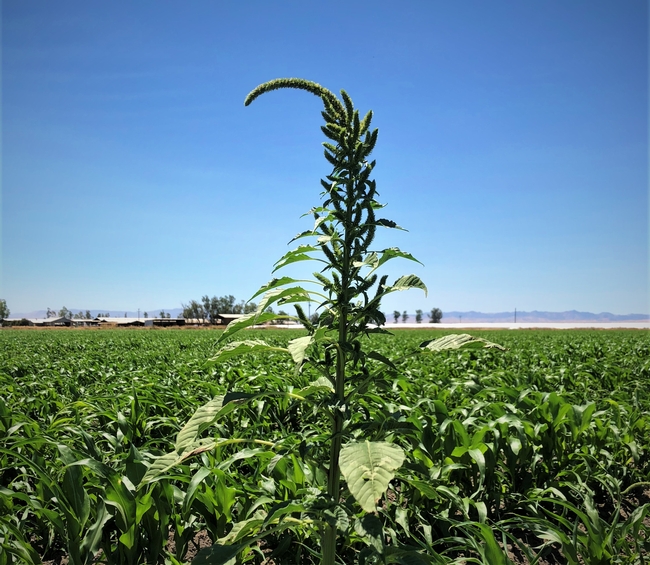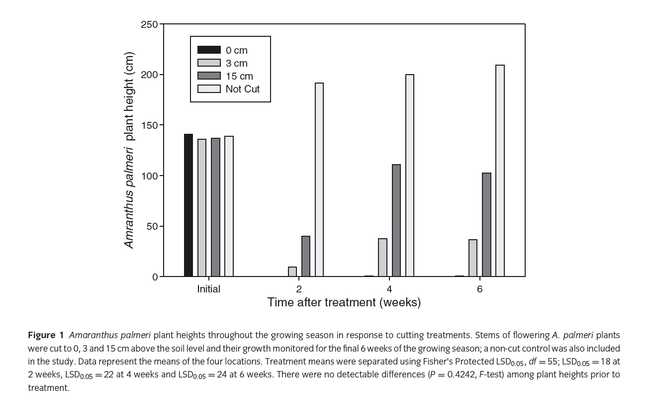A drive around parts of the San Joaquin Valley revealed some fields with Palmer amaranth (Amaranthus palmeri) rising above the crop canopy (See image below).
A male Palmer amaranth in a corn field in Merced County
Palmer amaranth is a tall (growing up to 10 feet in height), dioecious (male and female flowers develop on separate plants), summer annual that grows rapidly and produces significant amounts of seed (upwards of 400,000-1,000,000 per female plant). The species is extremely competitive with many crops, including corn and cotton. In the United States, Palmer amaranth populations with resistances to the ALS inhibitors (WSSA 2), EPSPS inhibitors (WSSA 9), HPPD inhibitors (WSSA 27), micotubule inhibitors (WSSA 3), PPO inhibitors (WSSA 14), and PSII inhibitors (WSSA 5) have been documented; this includes populations with resistances to two or more sites of action (http://weedscience.org/). In California (CA), glyphosate resistance has been confirmed, although the geographic distribution of the trait is largely unknown.
Hand-weeding is a common strategy for weed management in many CA crops. However, Palmer amaranth plants that have survived hand-weeding attempts have been known to re-grow and produce seed, sometimes in significant quantities. In 2014, my colleagues at the University of Georgia and I published a paper specifically looking at the intensity of defoliation on subsequent Palmer amaranth development (Sosnoskie et al. 2014 Ann Appl Biol 165:147-154) to address concerns that growers were having with late-season seed set following management efforts. With respect to the methodology: when Palmer amaranth began to flower (which was 8 weeks after cotton planting (PHY 375)), 10 pigweed plants per 25 feet of row were cut back to 1) the soil line, 2) ~1 inch above the soil line, and 3) ~6 inches above the soil line; a set of plants were left untreated as a control population. Weed heights were measured for up to 6 weeks following cutting. At cotton defoliation, seed was collected from the surviving female Palmer amaranth plants and the amounts and viability were quantified.
Plant survival, re-growth, and seed production were directly affected by the cutting height. 95% of the plants that were cut back to ground level died as compared to 64% of the plants cut back to 1 inch above the soil line and 35% of the plants cut back to 6 inches above the soil line. Palmer amaranth plants that survived the cutting treatments grew (from adventitious stem buds) to final heights of 40 inches (6 inch cutting treatment), 15 inches (1 inch cutting treatment) and <1 inch (cut to ground level). Comparatively, the untreated plants grew to heights of 86 inches. With respect to seed production, female plants in the control plots produced, on average, 400,000 seeds per plant; surviving plants cut back to 6 inches, 1 inch, and to the soil line produced approximately 100,000 seeds per plant, 35,000 seeds per plant, and 700 seeds per plant, respectively. Seed viability was not affected by cutting treatments (Mean germination = 76%).
While cotton yield can directly benefit from the removal of Palmer amaranth plants, the intensity of defoliation and stem removal could also have an impact future weed populations. To reduce the potential for competitive interference in subsequent crops, care must be taken to prevent as many seeds as possible from returning to the seed bank. Similarly, to minimize the risk of developing herbicide-resistant weeds and to manage existing populations, soil seed bank populations must also be addressed. Growers, farm managers, and crop advisors should be aware that hand-weeding failures can and do occur and that viable seed production can occur from Palmer amaranth plants that survive defoliation attempts.
Literature Cited:
Sosnoskie, L.M., T.M. Webster, T.L. Grey, and A.S. Culpepper. 2014. Severed stems of Amaranthus palmeri are capable of regrowth and seed production in Gossypium hirsutum. Annals of Applied Biology 165:147-154.
For more information about identifying commonly occurring pigweeds in California, please refer to this blog post: //ucanr.edu/blogs/blogcore/postdetail.cfm?postnum=27501
This post is also hosted at the Agronomy and Weed Science Blog
which is an extension of the Agronomy and Weed Science program at UCCE Merced County


